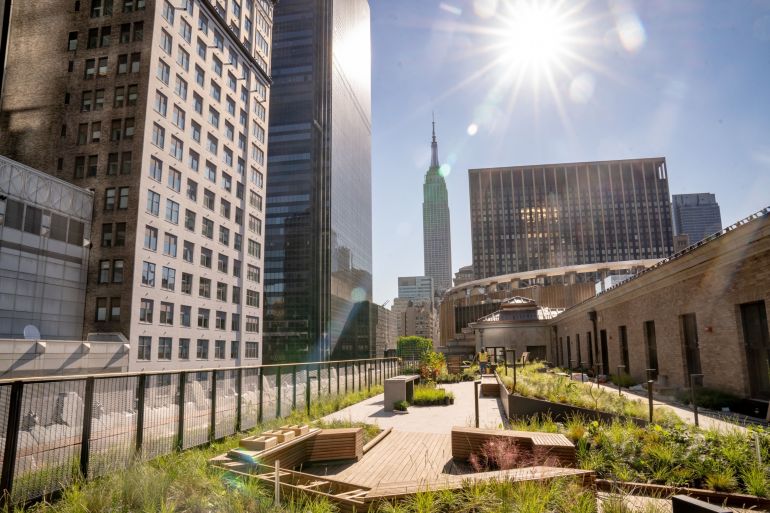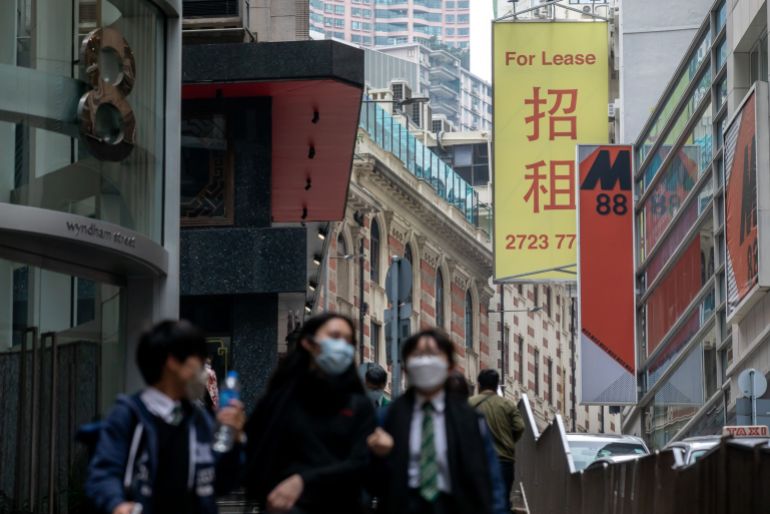The cloud over commercial real estate lingers
While landlords juggle, corporate leaders world over wonder how much real estate they really need after the pandemic.

Denver, United States – When Facebook committed to lease 67,800sq metres (730,000sq feet) of real estate at a former post office building in midtown Manhattan in 2020, New Yorkers from the mayor’s office to street vendors to the city’s real estate magnates cited the deal as evidence that office culture was not going to be another casualty of the COVID-19 pandemic.
But the deal Facebook (which calls itself Meta Platforms now) got was hardly the windfall that the building owner, Vornado Realty Trust, described in its marketing. In fact, it was later revealed that Vornado agreed to pay $150m to Facebook as an incentive to close the deal.
Keep reading
list of 4 itemsAmid Ukraine crisis, China’s ‘Zero COVID’ weighs on global growth
Photos: Signs of normalcy in India after two years of COVID curbs
White House outlines new plan to combat COVID in US
Despite bullish global commercial real estate outlooks from Big 4 accounting firms, the pandemic’s effect on the office subsector – in many ways the marquee slice of the global real estate industry – has been profound. Incentives like the one Facebook got, rent holidays, government stimulus and the long (often seven-to-ten year) leases typical in the office market have hidden the pain that the owners of this expensive real estate are feeling.
“All over the world, CEOs are wondering how to explain to their shareholders why 50-to-60 percent of their corporate real estate is basically vacant,” says Nicholas White, co-founder of Smart Buildings Certification, an Amsterdam-based consultancy. “They’re asking their CFOs for all sorts of data on which of these expensive properties to get rid of and which to keep. But it’s almost impossible to imagine that this won’t eventually affect what they can ask for rent, their vacancy rates and ultimately the values of the properties.”
Despite the realization that COVID variants like Delta and Omicron might continue to stalk the planet, the annual forecasts that global players like Deloitte, PwC, Cushman & Wakefield and others released at the start of the year were cautiously optimistic, a turnaround from the early days of the pandemic, when empty offices had people speaking of “the death of the office”. Views have moderated since COVID’s first year, and the consensus view now holds that the “new normal” will still include plenty of offices.
But how many? And what about the value of investments made before the pandemic. Commercial real estate is a hold-and-grow game in most regions, and many wonder if assumptions of 8-10 percent or even higher annual returns, often driving participation in such deals, can survive the COVID storm.
Cautious optimism
Real estate investment firm CBRE’s annual look at the market in Asia was entitled, “Harnessing Growth, Navigating Uncertainty”. The growth it speaks of is almost all in the residential and industrial (warehousing, storage, factories) spaces. If not quite dead, the office isn’t showing a whole lot of life from an investor perspective. “Many CRE firms are focusing on retrofitting properties and repurposing spaces for alternate uses to maximize value,” Deloitte’s global survey reports.
The retrofitting often involves converting offices whose long-term valuation now counts as “uncertainty”, to borrow a phrase. In some of the world’s largest cities – especially those which suffer from a shortage of affordable housing – this has led some office building owners to enter an entirely new market, “Office-to-Residential Conversions”.
In the US, the mismatch between office vacancy rates and housing supply is particularly acute. Real estate data firm RentCafe suggests that tens of thousands of such conversions will be created out of inert office space in 2022.

It’s not just in the US. The City of London announced a plan to create 1,500 new residences via such conversions in the midst of the claret bars and £100-a-plate ($130) lunch establishments. Berlin, Durban, Hong Kong, Sydney and other cities are also seeing the trend. And while the numbers are small, they reflect deteriorating prospects for office properties.
Chumming for fish
Fears that office real estate is experiencing a lease-locked calm before the storm explains the rent holidays, free parking spots and subsidized renovations like those Vornado ponied up for Facebook in 2020. The prospect of higher interest rates is another blow, raising the cost of capital for everything from maintenance to tenant acquisition to the post-pandemic expectation that landlords will address demands for sustainability and wellness.
“Many forward-thinking landlords do get this seismic shift in thinking about the nature of space and are leaning in hard in terms of technology investment to meet this new market reality,” says Michael Beckerman, CEO and founder of the influential New York-based real estate research firm CREtech. “Those that don’t will clearly be left behind.”
The general picture is glum.
Office availability rates in Tokyo remain at pandemic highs, above 8 percent, up from just 2 percent in 2019. Vacancies – a longer-term measure of empty spaces – in the city’s central business districts are forecast by Cushman & Wakefield to hover at about 6 percent well into 2024. India’s cities saw new leases decline by 39 percent in 2021; in Toronto, the figure for the downtown business district was a decline of 47 percent, according to real estate database firm CoStar. London’s office footprint fell by millions of square feet in 2021 as developers put projects on hold.
Nothing hurts a building’s valuation like low occupancy, which not only raises eyebrows among potential tenants but produces less revenue to distribute to a building’s investors. REITs – Real Estate Investment Trusts – attempt to arbitrage this risk by bundling dozens, hundreds or even thousands of properties into an indexed fund. That works fine if values slip in one geography but still perform in others. But the fear is that office real estate as an asset class may have passed its sell-by date. In a global pandemic, such arbitrage only works across asset classes.
Maurie Backman, a widely followed personal finance writer for investment adviser Motley Fool, says office REITS “are a sector I don’t want to touch anytime soon”. She is not one to declare offices dead, mind you. But “there’s little motivation for companies to rush to sign or renew leases when the world is still so unsettled from a pandemic-related perspective”.
Remote interest
Driving this uncertainty is a tectonic shift not just in people’s awareness that indoor spaces and density can be deadly but a deeper reevaluation of what it means to work in an office environment. Many, it turns out, kind of like working from home, taking a run in the middle of the day, or never getting out of their pyjama bottoms.
Surveys by corporations and landlords alike confirm that, while some are eager to get back into the office, a majority want to retain the new flexibility to work remotely that the pandemic forced upon management. Demographic trends in many markets, too, have accelerated this shift, as younger workers with no experience of 20th-century corporate culture recoil at the conformity of the old suit and tie commuter life.
“Clearly we’re not all about to walk back into work in the way that we used to,” says James O’Sullivan, who leads the post-COVID transformation team at the London-based consultancy Project One. “We’re going to have to take our time to work out which parts of our businesses are more suited to which ways of working. Some will be more suited to remote working, and others will be to being more back on site, and others will transition between the two.”
And that kind of talk scares the incentives out of commercial real estate owners.